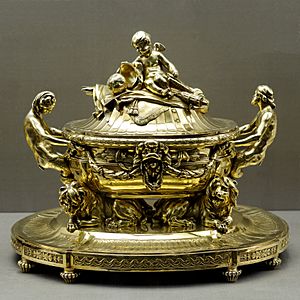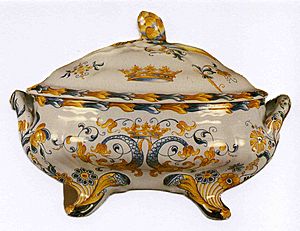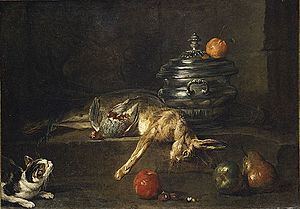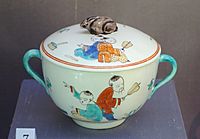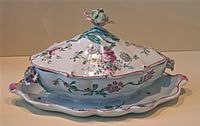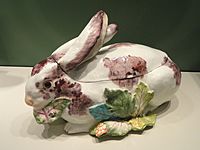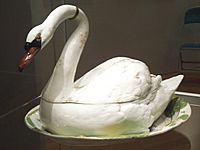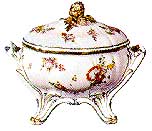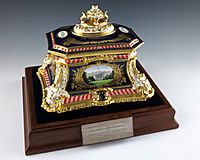Tureen facts for kids
A tureen is a special serving dish. People use it to hold and serve foods like soup or stew. Tureens are usually deep and wide. They often have handles and a lid with a knob. Over time, tureens have come in many shapes. Some are round or rectangular. Others look like animals or birds. Tureens can be made from porcelain, faience (a type of glazed pottery), or silver. They usually sit on a matching tray.
Contents
What's in a Name?
The word "tureen" comes from French. It might be linked to an older French word, terrine. This word meant a large, round pottery dish. Another idea is that it was named after a French military hero, Marshal Turenne. Tureens became popular in France in the late 1600s. Back then, they were called pot à oille, which was a type of soup.
History of Tureens
Tureens have a long history. They likely started from simple communal bowls that everyone shared. But during the time of King Louis XIV in France, tureens became very fancy. They changed from just a useful dish to a beautiful centerpiece for formal dinners.
In those days, people used to put all the food on the table at once. This was called service à la française. Later, a new way of serving started. Each course was brought out separately. This was known as service à la russe. Soup was almost always the first course. So, the tureen became an important part of starting a meal with style.
Some tureens were incredibly valuable. One silver tureen, made in 1733, sold for over 10 million US dollars! This shows how important and artistic these dishes could be.
Silver Tureens
Many silver tureens from the 1600s in France were melted down. This happened to help pay for King Louis XIV's wars. So, we can only see them in old paintings. Artists like Jean-Baptiste-Siméon Chardin painted these ornate silver tureens. His painting from 1728 shows a beautiful silver tureen from an earlier time.
Eighteenth Century Styles
In the mid-1700s, tureens often looked like natural things. For example, some were shaped like a head of cabbage. The Chelsea porcelain factory in England made tureens that looked like rabbits. A catalog from 1755 even advertised a "Fine tureen in the form of a rabbit as big as life."
Small Tureens: Écuelles and Saucières
Tureens are best for serving about six people. But there were also smaller versions. In 18th-century France, a small, individual covered bowl with handles was called an écuelle. It was like a mini tureen for one person. You could even pick it up by its handles and drink from it. Today, a two-handled cream soup bowl is similar.
A saucière was a small covered dish for sauce. It could also look like a tiny tureen. Sometimes, the saucière was attached to its tray. This made it easier to carry and stopped drips.
Tureen Collections
John T. Dorrance, whose family owned Campbell's Soup, started a huge collection of soup tureens in 1966. He later gave this amazing collection to the Henry Francis DuPont Winterthur Museum.
See also
 In Spanish: Sopera para niños
In Spanish: Sopera para niños



